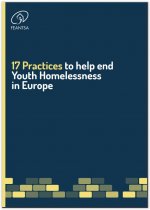
17 Practices to help end Youth Homelessness in Europe
Omschrijving
Young people experiencing, or at risk of, homelessness have a variety of needs which homeless services need to address to create sustainable solutions to exit homelessness for the long-term. In 2020 FEANTSA published the European Framework for Defining Youth Homelessness, which was designed to promote a shared understanding of youth homelessness in Europe.
This framework took an intersectional perspective and highlighted the different profiles that exist within youth homelessness and the challenges that youth can face in exiting homelessness. This guide is a follow-on report which aims to share insights, ideas and practices for how services across Europe can respond to the needs of young people. While FEANTSA has been calling for youth-oriented solutions designed to meet youth specific needs to not just support the transition out of homelessness but the transition to independent living, tackling youth homelessness requires an intersectional approach. Young people are not ‘just’ young people, they are not a homogenous group.
Within the profile of youth homelessness there can be a great diversity of experience which impacts on how supports should be designed and delivered to young people. This guide has been designed with a dual focus:
• Section 1 shares services to meet the broader needs of young people experiencing homelessness and includes practices around youth empowerment, housing, prevention, and mental health supports.
• Section 2 covers practices with a thematic focus that supports youth with specific experiences and includes services for youth leaving care, LGBTIQ youth, young women and young migrants
